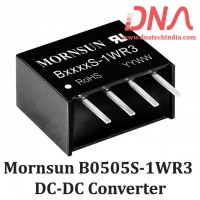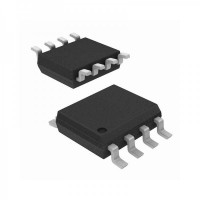Capacitance in AC Circuits |
||
|
When capacitors are connected across a direct current DC supply voltage they become charged to the value of the applied voltage, acting like temporary storage devices and maintain or hold this charge indefinitely as long as the supply voltage is present. During this charging process, a charging current, ( i ) will flow into the capacitor opposing any changes to the voltage at a rate that is equal to the rate of change of the electrical charge on the plates. This charging current can be defined as: i = CdV/dt. Once the capacitor is "fully-charged" the capacitor blocks the flow of any more electrons onto its plates as they have become saturated. However, if we apply an alternating current or AC supply, the capacitor will alternately charge and discharge at a rate determined by the frequency of the supply. Then the Capacitance in AC circuits varies with frequency as the capacitor is being constantly charged and discharged. |
||
|
We know that the flow of electrons through the capacitor is directly proportional to the rate of change of the voltage across the plates. Then, we can see that capacitors in AC circuits like to pass current when the voltage across its plates is constantly changing with respect to time such as in AC signals, but it does not like to pass current when the applied voltage is of a constant value such as in DC signals. Consider the circuit below. |
||
|
|
||
AC Capacitor Circuit |
||
|
|
||
|
In the purely capacitive circuit above, the capacitor is connected directly across the AC supply voltage. As the supply voltage increases and decreases, the capacitor charges and discharges with respect to this change. We know that the charging current is directly proportional to the rate of change of the voltage across the plates with this rate of change at its greatest as the supply voltage crosses over from its positive half cycle to its negative half cycle or vice versa at points, 0o and 180o along the sine wave. Consequently, the least voltage change occurs when the AC sine wave crosses over at its maximum or minimum peak voltage level, (Vm). At these positions in the cycle the maximum or minimum currents are flowing through the capacitor circuit and this is shown below. |
||
|
|
||
AC Capacitor Phasor Diagram |
||
|
|
||
|
At 0o the rate of change of the supply voltage is increasing in a positive direction resulting in a maximum charging current at that instant in time. As the applied voltage reaches its maximum peak value at 90o for a very brief instant in time the supply voltage is neither increasing or decreasing so there is no current flowing through the circuit. As the applied voltage begins to decrease to zero at 180o, the slope of the voltage is negative so the capacitor discharges in the negative direction. At the 180o point along the line the rate of change of the voltage is at its maximum again so maximum current flows at that instant and so on. Then we can say that for capacitors in AC circuits the instantaneous current is at its minimum or zero whenever the applied voltage is at its maximum and likewise the instantaneous value of the current is at its maximum or peak value when the applied voltage is at its minimum or zero. From the waveform above, we can see that the current is leading the voltage by 1/4 cycle or 90o as shown by the vector diagram. Then we can say that in a purely capacitive circuit the alternating voltage lags the current by 90o. |
||
|
We know that the current flowing through the capacitance in AC circuits is in opposition to the rate of change of the applied voltage but just like resistors, capacitors also offer some form of resistance against the flow of current through the circuit, but with capacitors in AC circuits this AC resistance is known as Reactance or more commonly in capacitor circuits, Capacitive Reactance, so capacitance in AC circuits suffers from Capacitive Reactance. |
||
|
|
||
Capacitive Reactance |
||
|
Capacitive Reactance in a purely capacitive circuit is the opposition to current flow in AC circuits only. Like resistance, reactance is also measured in Ohm's but is given the symbol X to distinguish it from a purely resistive value. As reactance can also be applied to Inductors as well as Capacitors it is more commonly known as Capacitive Reactance for capacitors in AC circuits and is given the symbol Xc so we can actually say that Capacitive Reactance is Resistance that varies with frequency. Also, capacitive reactance depends on the value of the capacitor in Farads as well as the frequency of the AC waveform and the formula used to define capacitive reactance is given as: |
||
Capacitive Reactance |
||
|
|
||
|
||
|
From the capacitive reactance formula above, it can be seen that if either of the Frequency or Capacitance where to be increased the overall capacitive reactance would decrease. As the frequency approaches infinity the capacitors reactance would reduce to zero acting like a perfect conductor. However, as the frequency approaches zero or DC, the capacitors reactance would increase up to infinity, acting like a very large resistance. This means then that capacitive reactance is "Inversely proportional" to frequency for any given value of Capacitance and this shown below: |
||
|
|
||
Capacitive Reactance against Frequency |
||
|
|
||
The capacitive reactance of the capacitor decreases as the frequency across it increases therefore capacitive reactance is inversely proportional to frequency.
The opposition to current flow, the electrostatic charge on the plates (its AC capacitance value) remains constant as it becomes easier for the capacitor to fully absorb the change in charge on its plates during each half cycle. Also as the frequency increases the current flowing through the capacitor increases in value because the rate of voltage change across its plates increases. |
||
|
|
||
Example No1. |
||
|
Find the current flowing in a circuit when a 4uF capacitor is connected across a 880v, 60Hz supply. |
||
|
|
||
|
So, the Capacitance in AC circuits varies with frequency as the capacitor is being constantly charged and discharged with the AC resistance of a capacitor being known as Reactance or more commonly in capacitor circuits, Capacitive Reactance. This capacitive reactance is inversely proportional to frequency and produces the opposition to current flow around a capacitive AC circuit as we looked at in the AC Capacitance tutorial in the AC Theory section. |
||
|
|
||
| Reproduced with permission from Wayne Storr | ||
| ( http://www.electronics-tutorials.ws/capacitor/cap_8.html ) | ||








